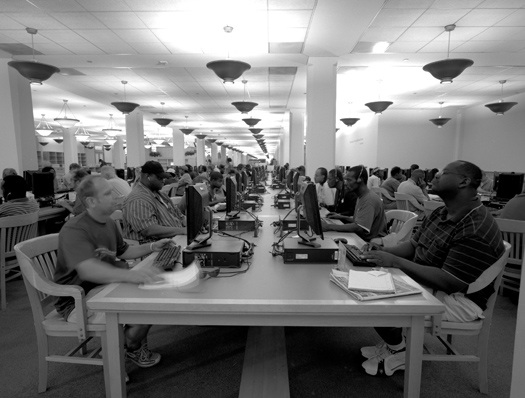Hardly a hayseed
March 11, 2012 • 7 Comments • Posted in blindness, guide dogs, Seeing Eye dogs, travel, UncategorizedBack in the early 90’s, when I was working with my first Seeing Eye dog Dora, three different blind people using guide dogs died after falling into subway tracks. A 1993 NY Times story reported that in one accident at the midtown subway stop, “witnesses said Ms. Schneider got up and tried to find the edge of the platform with her hands as a southbound No. 3 express train roared into the station with its horn blasting.”
I’m not afraid of much, but I am afraid of getting onto subways alone with a Seeing Eye dog. I always enlist a friend to come along as a sighted guide.
Plenty of people who use guide dogs take the subway safely back and forth to work every day, and my friend Karen Keninger is about to join those brave souls. Here’s her guest post about learning the DC Metro system with her new Seeing Eye dog Jimi.
Have any tips? Bring them on
by Karen Keninger
I am an Iowa girl. I make no apology. We don’t have Metros here. We have some busses, but no subways. So my experience of the subways is limited to going with friends while I’ve been in D.C. and a couple excursions in New York. This weekend we passed through eight or nine Metro stations learning how to get from point A to point Z via points D J and Q. I’m confident that in a month or two the Metro will be old hat and no big deal, but this weekend it was not.
Every station is laid out differently. Although they are clean, well lit, well patrolled, safe, and loaded with excellent signage, it’s going to be a challenge figuring out where to go at each point. For example, there is a talking and Brailled machine to buy your fare cards out of–very easy to use. But how do you know which gates are open to go in and which only go out? They all look the same, and the pattern is not consistent from station to station. Jimi got pretty good at the escalators, but once you get on the platform, how do you know whether it’s a blue train or an orange one? Oh, and how do you know whether it’s the train going out of the city or into it? And it matters!
They’re announcing it, and there are speakers on the outside of the trains, but they’ve said it so often that it’s a monosyllabic grunt most of the time in a particular accent that I’m not used to. The only thing that is easy to understand is the ubiquitous announcements that blare out from the speakers on the posts telling you not to run on the platform, to hold your child’s hand, and to stand back to let passengers off the train. Of course these announcements mask anything you might otherwise have been able to understand from the train conductor announcements.
I have received two specific pieces of advice from people living in D.C. regarding the metro. One is “Don’t live on the green line.” The other is “Pick a commute where you won’t have to change trains.” Excellent advice, but impossible to follow. NLS is on the green line.
For those of you who, like me, are not used to subways, let me see if I can describe them from my point of view. (You cosmopolitan types can skip this part!) First there is an escalator that takes you down from the street. This escalator may or may not be operating depending on who knows what. You prefer to walk down rather than up, and some of them are really, really long escalators. Then there is a row of gates with an attendant’s kiosk in the middle of the row. You don’t know which way the gates are going if you can’t see the lights, because each one can go either in or out depending on I don’t know what. You put your fare card into a slot on your side of the gate. The slot has Braille on it, but you don’t really have time to read “insert card here,” and they all say the same thing. It is sucked away and pops up on top maybe 18 inches away. You pull it out and the gate opens. This way the system knows where you entered.
After the gates may be another set of escalators, shorter this time, taking you down to the platform. Or you might be on the platform. Or you might be on one platform, with another one down below–at which point it is useful to know where you are going lest you end up somewhere else. Sometimes the platform is between two tracks, and you pick the train going your direction of the proper color. (There are red, green, yellow, orange and blue trains, and soon to be silver as well.) Sometimes the two tracks are next to each other and the platforms are on the outside of the trains, so if you start on the wrong side you have to go over a bridge to get to the other side. Sometimes the trains at one level go one way and the trains on the other level go the other way. Sometimes trains of different colors use the same track, alternating blue and orange for instance. Sometimes the trains on the upper level go east and west and the ones on the lower level go north and south. (Please note that cardinal directions are meaningless and used only for illustrative purposes here. The inside of the station has as far as I could tell no relevance whatsoever to the real world.)
Your only hope of survival seems to be to memorize each station as a unique and unduplicated space and forget everything you thought about stations in general. Nothing applies. Except that at each station at least one escalator is likely to be out of service. You will note, however, one safety feature that you may come to appreciate–truncated domes on the edge of the platform. Jimi is supposed to be afraid of empty subway tracks. He isn’t. but when I feel those truncated domes (little bumps) under my feet, I know to move him over. Don’t worry, Mom, I’m not going to fall in. So assuming that you find the right train, you wait for the doors to open. This part is easy, and Jimi bolts for the open door. He loves trains! You stride on with confidence and reach for a pole. You hope you find the pole before you find a body, because groping people is not your plan. You hang on because the car is going to start with a jerk and knock you on your tush if you’re not holding on or sitting down.
The next challenge is to know when to get off. Again, the conductor may be your friend, but may not. I think they’re supposed to announce each stop, but I don’t think they always do it in English. At any rate you need to keep track. I find counting on my fingers is the only way I can remember whether we passed Foggy Bottom or not. I’ll have to transfer from the orange train to the green train to get to work. L’Enfant Plaza had my head swimming on Saturday. We tried it again on Sunday and it made more sense. I just hope I don’t get lost my first day of work!!
And then, if you’re lucky, you get off at the right station–and wonder which way is out! Again, the possibilities seem to be endless. First of all, it matters which part of the train you’re on–front? Back? Middle? Did you remember to pay any attention to this little detail? Finding the escalators will be easier if you know how far up the platform you are. Then there are the gates again. You put your fare card in the slot again on the way out and the system knows how much to charge you for the trip. And then some stations have multiple exits. Am I on Georgia going north, or Georgia going south? How can I tell? H’m!!
The metro gets you places in a hurry–it’s just a matter of getting where you want to go. I haven’t experienced rush hour yet–I’m sure that will be a totally different experience from Saturday and Sunday! I’m going to go back through my audio notes and write it all down and with luck I’ll get to work the first day without getting lost!
Now, I know that those of you reading this who live in Boston, or Chicago, or New York, or San Francisco think,”What a rube!! What a hayseed! It’s not that big a deal!!” So if you have tips and tricks, bring them on!!






